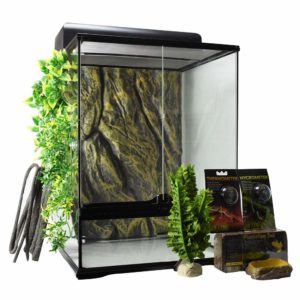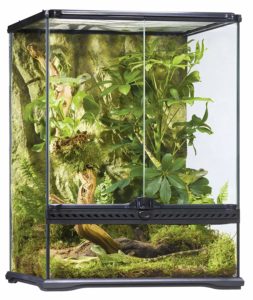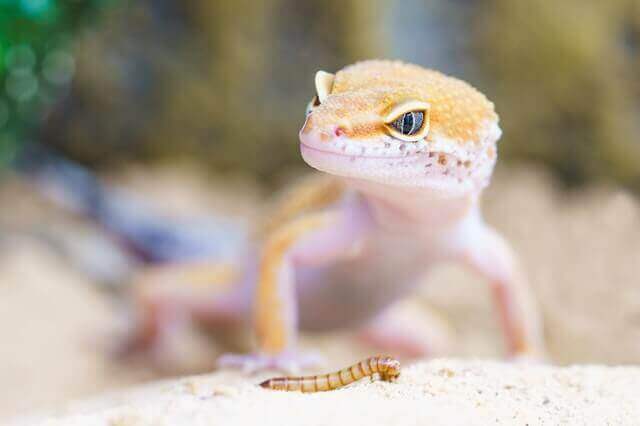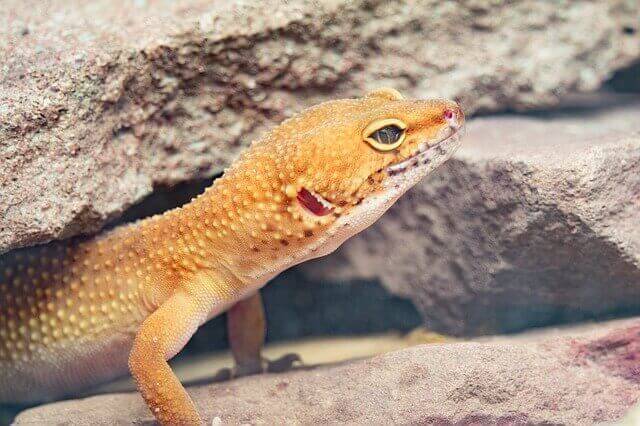Best Leopard Gecko Light 2020
leopard gecko lives in the dry rocky grasslands of Afghanistan, northwest Pakistan and India. Today they are popular as pets due to their small size and easy care. They are easily bred in captivity, as they are gentle, docile and rarely bite.
The captive lizards have a variety of colours and patterns on their skin unlike the ones in the wild. They don’t have sticky toe pads, but have eyelids unlike the other lizards, therefore can’t climb walls.
They need a warm, moist and well-ventilated terrarium to live in. Provide them with half logs for hiding and climbing. They are active during the night and mostly sleep during the day. So care should be given to the lighting of their habitat.
Best Leopard Gecko Light
Moonlight Bulb – Leopard Gecko light
| Product Name | Product Preview | Product Price |
|---|---|---|
| Exo Terra Night-Glo Moonlight |
 |
Buy Now |
- Pack of 4 Exo Terra Night-Glo Moonlight A19 Lamp, 75-Watt
- Moonlight lamp; Simulates natural moonlight
- Provides tropical night time temperatures
- Stimulates breeding behaviour in reptiles and amphibians
- A19 bulb; Combine with Repti-Glo or Sun-Glo for a 24-hour cycle Perfect for nocturnal viewing. leopard gecko light
There are many ways to keep the environment healthy in the terrarium. You need to keep in mind that temperature plays a major role in light, as they both provide heat.
- Therefore, if you are using a mat heater, do not use UV lights.
- A small blue bulb can provide light to help it roam in the habitat and also allow you to watch your pet’s movements and not disturb it.
- Mat heaters are recommended as the reptiles lie on their stomach and absorb the heat as they aren’t basking animals. One of the best leopard gecko light available in 2020.
UV lights for Leopard Gecko
| Product Name | Product Preview | Product Price |
|---|---|---|
| Evergreen 100 Watt UV Light for Reptile |
 |
Buy Now |
- This leopard gecko light is PERFECT DAYLIGHT BULB FOR YOUR CRITTER: Powerful source of heat and UVA / UVB / visible light – completely self-ballasted (no harmful UVC). Our mercury vapour bulb provides animals warmth & vitamin production necessary for health – just like daylight
- IDEAL FOR A WIDE VARIETY OF REPTILES AND AMPHIBIANS: Our UVA UVB reptile light is ideal for bearded dragons, tortoises, turtles, geckos, snakes (pythons, boas, etc.), iguanas, lizards, chameleons, frogs, toads & more. An excellent reptile bulb!
- COMPATIBLE WITH ALL ENCLOSURES: Our large UVA UVB bulb is compatible with a variety of enclosures, including vivariums, tanks, terrariums, vision cages, and more. Perfect for those in need of reptile UVB light and UVB bulbs (light for reptiles)
These lights or sunlight does not hurt the animals, but you need to provide hiding places in their enclosure. A UV light can heat up the environment and also aid in their calcium absorption. Be careful to maintain the day temperature at 24C/ 75F and their basking spot at 31C/ 88F. T8 bulbs should be replaced every 6 months and T5 bulbs every 9 months.
Ceramic Heat Emitter
| Product Name | Product Preview | Product Price |
|---|---|---|
| OMAYKEY 100W 2 Pack Ceramic Heat Lamp with 1-pcs Digital-Thermometer |
 |
Buy Now |
-
This 100W black infrared heat lamp is made of solid ceramics element, it has a perfect heat radiation feature and no light emitted. Great for pet, lizard, coop, chicken, turtle, snake, chameleon, bearded dragon, aquarium, with one digital thermometer included
-
This ceramic heat lamp is simple and easy to install, just screw it into a standard porcelain E27 screw socket (ATTENTION: Use only with a porcelain socket, because the plastic socket may melt the lamp holder)
-
This heat lamp’s input voltage is AC 90-120V, power is 100-Watts, full size is diameter 3.15-inch x height 4.13 inch
-
This ceramic heat emitter bulb is 24hr heat source, with 100% efficiency, perfect for reptiles and amphibians. It could last 9000-15,000 hours, even longer.
-
This bulb‘s surface temperature is very high when working, please do not use your hand to test the temperature. Do not touch the heat lamp immediately after turning off, please wait at least 1 hour to cool down. Also please adjust the distance between the heat lamp/leopard gecko light and the pets.
These provide direction heat but no light. They are a safe, economical and effective way of providing heat to the reptile constantly. Using a wire clamp lamp will ensure that the ceramic heat emitter does not overheat. One of the best leopard gecko light available in 2020.
Zoo Med’s Basking combo pack
| Product Name | Product Preview | Product Price |
|---|---|---|
| Zoo Med Day/Night Light Combo Pack |
 |
Buy Now |
- Daylight spotlight and an infrared heat light for leopard gecko
- Spot lamp emits a concentrated heat source for basking reptiles
- The infrared bulb is a 24-hour heat source perfect for nocturnal reptiles
This pack includes 2 bulbs for day and night heating.
Repti Basking Spot Lamp: This lamp is for day time. It has a patented computer designed “double reflector” focusing 35% more light/ heat in the beam and can last for 2000 hours.
Nocturnal Infrared Heat lamp: This is a 75 Watt leopard gecko light gives 24-hour heat and is excellent for viewing the animals.
Exo Terra Heat-Glo Infrared leopard gecko light
| Product Name | Product Preview | Product Price |
|---|---|---|
| Exo Terra Heat-Glo Infrared Spot Lamp |
 |
Buy Now |
- Pack of 4 Exo Terra Heat-Glo Infrared Spot Lamp, 75-Watt/120-Volt
- A powerful source of infrared heat emissions
- Increases overall air temperature of the terrarium
- Ideal for nocturnal viewing
- Can be combined with Exo Terra Repti-Glo or Sun-Glo bulbs
This bulb emits infrared heat and the spot lamp has a built-in reflector for giving heat I any particular direction. This leopard gecko light does not prevent any normal activity of the animals and provides heat which increases the sir temperature helping in their digestion. They can be combined with Daytime Heat Lamp or Night Heat Lamp.
Some common leopard gecko lights available in the market
| Product Name | Product Preview | Product Price |
|---|---|---|
| Exo Terra Daylight Basking Spot Lamp 75w |
 |
Buy Now |
| Zoo Med Day/Night Tropical Lighting Kit |
 |
Buy Now |
| Zoo Med Combo Deep Dome Dual Lamp Fixture |
 |
Buy Now |
| Zoo Med PowerSun H.I.D Metal Halide UVB Lamp & Lamp Fixture |
 |
Buy Now |
| LUCKY HERP 100 Watt UVA UVB Mercury Vapor Bulb |
 |
Buy Now |
| Zoo Med Reptile Halogen Bulb |
 |
Buy Now |
| Zilla (3 Pack) Day Blue Light Incandescent Bulb for Reptiles Watt: 75 Watts |
 |
Buy Now |
| Zoo Med Moonlite Bulb for Reptiles |
 |
Buy Now |
| Zoo Med ReptiSun 5.0 Mini Compact Fluorescent Lamp |
 |
Buy Now |
| Bulb High Intensity Sun Simulating Bulb Lamp |
 |
Buy Now |
Exo Terra Sun-Glo Basking Spot Lamp
This is a 100- watt broad-spectrum daylight leopard gecko light with a Neodymium sleeve. It gives the animals a more natural appearance and stimulates breeding. It directs the heat to one spot creating a basking site in the terrarium. It has a thermal efficiency of 93%. It can be combined with a Night Glo or Heat Glo Bulbs for maintaining a 24-hour cycle.
Zoo Med Day & Night Combo Pack Reptile Bulbs
It includes one daylight blue and one nightlight red 60-watt bulbs.
Daylight Blue: Is a 60-watt bulb for heating the terrarium. As it is an uncoated blue glass it has better heat transfer and better burn life.
Nightlight Red: This is a true red glass heat lamp and is perfect for viewing the nighttime behaviour of the animals. It is also a 60-watt bulb with long-lasting burn life.
Zoo Med Mini Combo Deep Dome Reptile Lamp Fixture
This product gives you two fixtures in one dome providing maximum convenience. It has a polished aluminium dome which increases the light and the UV output by 30%. The dual ceramic sockets allow two 100 watt bulbs, one a Basking Spot Lamp or a Power Sun UV lamp and one Nightlight Heat Lamp. The deep dome prevents the lamps from sticking out.
PowerSun H.I.D
This provides daylight and helps in day time viewing. It provides high heat. It can provide both UVB and UVA light to the reptiles essential for their bones and promoting natural behaviours.
Zoo Med PowerSun UV Bulb
This helps in giving both UVB and UVA light. It provides high heat and helps in basking of the reptiles. It is used in large terrariums. It fits into one ceramic socket.
Zoo Med Repti Halogen Bulbs
This bulb gives 15% more heat, light and UVA output than other basking lamps. It is specifically for reptiles but has a low burn out point and doesn’t last for long.
Daylight blue
This establishes visible daylight which is essential for their natural light circle and should be used for 12-14 hours in a day. It gives low heat and provides UVA light which helps in promoting natural behaviours.
Zoo Med’s Moonlite Reptile Bulb
This bulb provides moonlight lighting for viewing reptiles at night. The light does not interfere with their sleeping patterns and is made of pure deep blue glass which is neither painted or coated in blue. It provides 24-hour heat to the animals.
Reptisun 5.0
this light is perfect for all kinds of reptiles and amphibians. The Mini Compact Fluorescent lamps have special UVB transmitting Quartz glass for maximum UVB penetration. They can be threaded into standard sockets and the lamps can be placed either vertically or horizontally in the fixtures. This light prevents bone diseases and the light helps in increasing feeding and mating processes.
Arcadia Natural Sunlight 2% UVB lamp
These lamps give the better stimulating level of sunlight to the reptiles and snakes. A healthy amount of UVA and UVB rays are given to the animals. This lamp recreates the natural environment of the animals by providing the amount of UV received from the natural sun.
This light helps the reptiles in synthesizing vitamin D3 which helps them to absorb the calcium in their diet, thus leading to strong bones.
This leopard gecko light produces excellent natural colours.
Important notes for mimicking natural light environment
- Since these reptiles sleep for the most part of the day, daytime light is not very important, but a heat source needs to be provided. It is very important to provide proper heat to the tank; therefore, you may use a standard light bulb as a source of light provided you have under tank heaters.
- Do not provide your natural light coming from your windows as your light cycle is different from their natural habitat light cycle. Therefore try to mimic their light cycle, meaning in summers provide 14 hours of light and 10 hours of darkness, while in winters equal hours of light and darkness. When transiting from summer to winter make sure you do it gradually with a 15-30-minute interval in 4-8 weeks.
- A basking light can provide heat as well as light so you won’t have to purchase different types of lights.
- UVB are generally not required but the lizards feel better when exposed to few hours to a full spectrum UV bulb. It helps in avoiding skeletal-related diseases like metabolic bone disease, as they are kept indoors away from their natural habitat.
- Avoid using bright lights as this stresses and irritates the animals.
- If your terrarium is not maintaining correct heat use an infrared heat lamp. This will provide heat and the light will not disturb the animals.
- Avoid using hot rocks as they can get very hot, also these animals do not move often and keep lying they may get burned.
- Humidity in the tank should be maintained at 20%-40% to help the reptiles shed properly. You can maintain the humidity by keeping a bowl of water or a moist moss in the tank and check humidity levels on a regular basis by a hygrometer.
- Lack of humidity can cause dehydration, constricted circulation, loss of weight and no hunger leading to their death.
- Maintain a heat gradient in the tank, meaning a hot side and a cool side. This a great way to prevent the reptile from getting overheated or becoming too cold as they can move from one side to another for enjoying the different temperatures. Thus use a thermometer for both sides to help regulate the temperatures.
- Monitoring of the tank temperatures should be done every day. The heat provided is also dependent on the outside room temperature where the terrarium is kept.
Caution:
The Albino morphs have naturally sensitive eyes, therefore should not be exposed to UV light. Since albinism causes the skin and eyes to be very sensitive to light. Care should be taken when providing light to the tank. Using an incandescent bulb or an LED panel can help the animal differentiate between daytime and nighttime.




